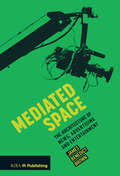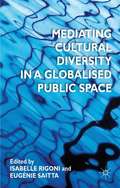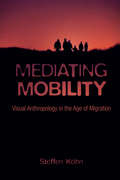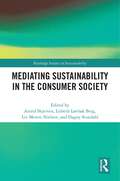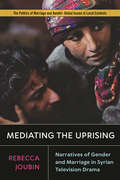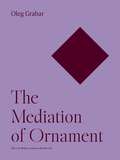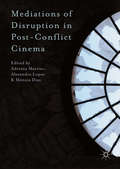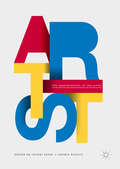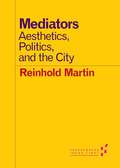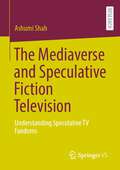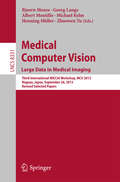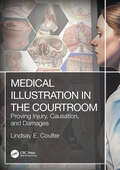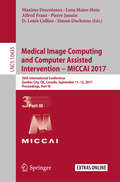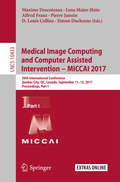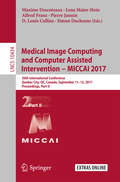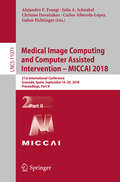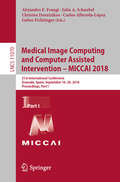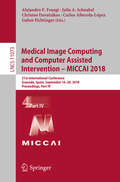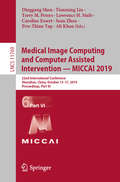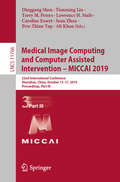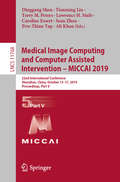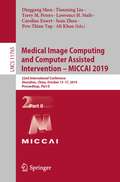- Table View
- List View
Mediated Space
by James BrownAs the social media revolution embeds itself in our daily lives, and as those who once consumed media become producers, established broadcast media producers are witnessing the dissolution of trust in their established authority. Mediated Space critiques contemporary intersections of Architecture and broadcast media that exploit spaces and places that are real, imagined or hybrids of the two in order to re-establish and strengthen the power of traditional capitalist mechanisms of production and consumption. Examining eight spatial constructions in North America, Europe, the Middle East and Africa, Mediated Space embarks on a global exploration of how architecture, spatial design and technology conspire in the service of global capitalism. In three thematic parts that focus on the automotive space of the city, the journalistic space of the news room and the mediated skyline of the city, Mediated Space makes an architectural critique of spaces that are rarely designed by architects but that are experienced every day by millions of people.
Mediating Alzheimer's: Cognition and Personhood
by Scott SelbergAn exploration of the representational culture of Alzheimer&’s disease and how media technologies shape our ideas of cognition and aging With no known cause or cure despite a century of research, Alzheimer&’s disease is a true medical mystery. In Mediating Alzheimer&’s, Scott Selberg examines the nature of this enduring national health crisis by looking at the disease&’s relationship to media and representation. He shows how collective investments in different kinds of media have historically shaped how we understand, treat, and live with this disease. Selberg demonstrates how the cognitive abilities that Alzheimer&’s threatens—memory, for example—are integrated into the operations of representational technologies, from Polaroid photographs to Post-its to digital artificial intelligence. Focusing on a wide variety of media technologies, such as neuroimaging, art therapy, virtual reality, and social media, he shows how these cognitively oriented media ultimately help define personhood for people with Alzheimer&’s. Media have changed the practices of successful aging in the United States, and Selberg takes us deep into how technologies like digital brain-training and online care networks shape ideas of cognition and healthy aging.Packed with startlingly fresh insights, Mediating Alzheimer&’s contributes to debates around bioethics, the labor of caregiving, and a national economy increasingly invested in communication and digital media. Probing the very technologies that promise to save and understand our brains, it gives us new ways of understanding Alzheimer&’s disease and aging in America.
Mediating Cultural Diversity in a Globalized Public Space
by Isabelle Rigoni Eugénie SaittaThrough enhancing reflection on the treatment of cultural diversity in contemporary Western societies, this collection aims to move the debate beyond the opposition between ethnicity and citizenship and demonstrate ways to achieve equality in multicultural and globalised societies.
Mediating Mobility: Visual Anthropology in the Age of Migration (Nonfictions)
by Steffen KöhnImages have become an integral part of the political regulation of migration: they help produce categories of legality versus illegality, foster stereotypes, and mobilize political convictions. Yet how are we to understand the relationship between these images and the political in the discourse surrounding migration? How can we, as anthropologists, migration scholars, or documentary filmmakers visually represent people who are excluded from political representation? And how can such visual representations gain political momentum? This volume not only considers the images that circulate with reference to migrants or draw attention to those that accompany, show, or conceal them. The book explores the phenomena of migration with the help of images. It offers an in-depth analysis of the documentary approaches of Ursula Biemann, Renzo Martens, Bouchra Khalili, Silvain George, Raphael Cuomo and Maria Iorio, Alex Rivera, and Rania Stepha, which evoke the particularities of migrant lifeworlds and examine urgent questions regarding the interrelations between politics and poetics, mobility and mediation, and the ethics of probability and possibility. The author also discusses his own cinematic practice in the making of Tell Me When... (2011), A Tale of Two Islands (2012), and Intimate Distance (2015), a trilogy of films that explore the potential to communicate the bodily, spatial, and temporal dimensions of the experience of migration.
Mediating Sustainability in the Consumer Society (Routledge Studies in Sustainability)
by Astrid Skjerven Lisbeth Løvbak Berg Liv Merete Nielsen Dagny StuedahlThis book sheds light on the role and impact of sustainability mediation, an effective tool for political authorities and business enterprises to persuade consumers of the integrity of their actions, products, and services.In this era of ecological and societal crises fuelled by increasing consumption, sustainability has become a key buzzword and target to attain. Governments around the world argue that they will meet their sustainability goals through environmental actions, by enabling consumers to make better choices and expecting brands to respond accordingly. At the same time, consumers are overwhelmed by the messaging conveyed in sustainability marketing campaigns, often featuring misleading greenwashing, with political authorities, organisations, and business enterprises all having conflicting interests. In this complex scenario, mediation has become a crucial issue. This book offers a critical and multidisciplinary view of sustainability mediation from experts in the fields of philosophy, consumption research, media studies, fashion, design, and citizenship, offering a unique, holistic view. Each chapter highlights different and problematic aspects of the cultural narratives being communicated, for example, the necessity of growth and the notion of a green economy. They present current theories, methods, indicators, and strategies used to assess and measure the relation between mediation, behaviour, and sustainable development.This book is of interest to scholars, researchers, and postgraduate students in all subject fields concerned with sustainability, including design, visual communication, fashion, consumption, media and journalism, and sustainable development.
Mediating the Uprising: Narratives of Gender and Marriage in Syrian Television Drama (Politics of Marriage and Gender: Global Issues in Local Contexts)
by Rebecca JoubinMediating the Uprising: Narratives of Gender and Marriage in Syrian Television Drama shows how gender and marriage metaphors inform post-uprising Syrian drama for various forms of cultural and political critique. These narratives have become complicated since the uprising due to the Syrian regime’s effort to control the revolutionary discourse. As Syria’s uprising spawned more terrorist groups, some drama creators became nostalgic for pre-war days. While for some screenwriters a return to pre-2011 life would be welcome after so much bloodshed, others advocated profound cultural and social transformation, instead. They employed marriage and gender metaphors in the stories they wrote to engage in political critique, even at the risk of creating marketing difficulties for the shows or they created escapist stories such as transnational adaptations and Old Damascus tales. Serving as heritage preservation, Mediating the Uprising underscores that television drama creators in Syria have many ways of engaging in protest, with gender and marriage at the heart of the polemic.
The Mediation of Ornament (The A. W. Mellon Lectures in the Fine Arts #38)
by Oleg GrabarHow ornamentation enables a direct and immediate encounter between viewers and art objectsBased on universal motifs, ornamentation occurs in many artistic traditions, though it reaches its most expressive, tangible, and unique form in the art of the Islamic world. The Mediation of Ornament shares a veteran art historian’s love for the sheer sensuality of Islamic ornamentation, but also uses this art to show how ornament serves as a consistent intermediary between viewers and artistic works from all cultures and periods. Oleg Grabar analyzes early and medieval Islamic objects, ranging from frontispieces in Yemen to tilework in the Alhambra, and compares them to Western examples, treating all pieces as testimony of the work, life, thought, and emotion experienced in one society. The Mediation of Ornament is essential reading for admirers of Islamic art and anyone interested in the ways of perceiving and understanding the arts more broadly.
Mediations of Disruption in Post-Conflict Cinema
by Adriana Martins Alexandra Lopes Mónica DiasMediations of Disruption in Post-Conflict Cinema is a transdisciplinary volume that addresses the cinematic mediation of a wide range of conflicts. From World War II and its aftermath to the exploration of colonial and post-colonial experiences and more recent forms of terrorism, it debates the possibilities, constraints and efficacy of the discursive practices this mediation entails. Despite its variety and amplitude in scope and width, the innovative and singular aspect of the book lies in the fact that the essays give voice to a variety of regions, issues, and filmmaking processes that tend either to remain on the outskirts of the publishing world and/or to be granted only partial visibility in volumes of regional cinema.
The Mediatization of the Artist
by Rachel Esner Sandra KistersThis book offers trans-historical and trans-national perspectives on the image of "the artist" as a public figure in the popular discourse and imagination. Since the rise of notions of artistic autonomy and the simultaneous demise of old systems of patronage from the late eighteenth century onwards, artists have increasingly found themselves confronted with the necessity of developing a public persona. In the same period, new audiences for art discovered their fascination for the life and work of the artist. The rise of new media such as the illustrated press, photography and film meant that the needs of both parties could easily be satisfied in both words and images. Thanks to these "new" media, the artist was transformed from a simple producer of works of art into a public figure. The aim of this volume is to reflect on this transformative process, and to study the specific role of the media themselves. Which visual media were deployed, to what effect, and with what kind of audiences in mind? How did the artist, critic, photographer and filmmaker interact in the creation of these representations of the artist's image?
Mediators: Aesthetics, Politics, and the City (Forerunners: Ideas First)
by Reinhold MartinReinhold Martin&’s Mediators is a series of linked meditations on the globalized city. Focusing on infrastructural, technical, and social systems, Martin explores how the aesthetics and the political economy of cities overlap and interact. He discusses a range of subjects, including the architecture of finance written into urban policy, regimes of enumeration that remix city and country, fictional ecologies that rewrite biopolitics, the ruins of socialism strewn amid the transnational commons, and memories of revolution stored in everyday urban hardware. For Martin, these mediators—the objects, processes, and imaginaries from which these phenomena emerge—serve to explain disparate fragments of a global urbanity.Forerunners: Ideas First is a thought-in-process series of breakthrough digital publications. Written between fresh ideas and finished books, Forerunners draws on scholarly work initiated in notable blogs, social media, conference plenaries, journal articles, and the synergy of academic exchange. This is gray literature publishing: where intense thinking, change, and speculation take place in scholarship.
The Mediaverse and Speculative Fiction Television: Understanding Speculative TV Fandoms
by Ashumi ShahSome (web) television texts achieve immense commercial success. Certain commercially successful texts boast dedicated, creative, and exponentially growing fandoms. These fan communities engage in specific fan practices that are significantly influenced by the textualities of the texts and their contexts of production, distribution, and consumption. Increased fan engagement resulting in the acceleration of the text’s popularity leads to the following inquiries: · How is the series influenced by the interactions among and the relationships between the producers, consumers, distributors, and content? · What are the sites of these interactions? · What are the social, cultural, economic, and political factors that impact the series? · How do the text’s contexts of production, distribution, and consumption lead to the text’s popularity in mainstream media? In pursuit of an answer to these questions, the analytical lens of the ‘mediaverse’ is developed. An inductive study, this book explores four television series’ that fall within the scope of speculative fiction to characterise the mediaverse and highlight the interconnectedness among the networked nodes of new media. These wield a significant influence on the production and consumption of media and its presence in our everyday lives, thus outlining the mediaverse as a tool for the analysis of a media texts and practices that shape contemporary media culture.
Medical and Dental Space Planning: A Comprehensive Guide to Design, Equipment, and Clinical Procedures
by Jain MalkinTHE UPDATED DEFINITIVE REFERENCE ON MEDICAL AND DENTAL OFFICE DESIGN Medical and Dental Space Planning is an indispensable guide to the myriad of details that make a medical or dental practice efficient and productive. The unique needs of more than thirty specialties, as well as primary care, are explained in the context of new technology and the many regulatory and compliance issues influencing design. Concepts are also presented for ambulatory surgical centers, diagnostic imaging, clinical laboratories, breast care clinics, endoscopy centers, community health centers, radiation oncology, and single-specialty and multispecialty group practices and clinics. A thorough review of the latest dental technology and many creative space plans and design ideas for each dental specialty will be of interest to both dentists and design professionals. Important topics like infection control are top of mind, influencing every aspect of dental office design. An "inside look" at what goes on in each specialist's office will familiarize readers with medical and dental procedures, how they are executed, and the types of equipment used. Technology has radically impacted medical and dental practice: digital radiography, electronic health records, mobile health devices, point-of-care diagnostic testing, digital diagnostic instrumentation, CAD/CAM systems for digital dental impressions and milling of restorations in the dentist's office, portable handheld X-ray, and 3D cone beam computed tomography for dentists all have major implications for facility design. The influence of the Affordable Care Act is transforming primary care from volume-based to value-based, which has an impact on the design of facilities, resulting in team collaboration spaces, larger consultative examination/assessment rooms, and accommodation for multidisciplinary practitioners who proactively manage patient care, often in a patient-centered medical home context. The wealth of information in this book is organized to make it easy to use and practical. Program tables accompany each medical and dental specialty to help the designer compute the number and sizes of required rooms and total square footage for each practice. This handy reference can be used during interviews for a "reality check" on a client's program or during space planning. Other features, for example, help untangle the web of compliance and code issues governing office-based surgery. Illustrated with more than 600 photographs and drawings, Medical and Dental Space Planning is an essential tool for interior designers and architects as well as dentists, physicians, and practice management consultants.
Medical Computer Vision. Large Data in Medical Imaging: Third International MICCAI Workshop, MCV 2013, Nagoya, Japan, September 26, 2013, Revised Selected Papers (Lecture Notes in Computer Science #8331)
by Bjoern Menze, Georg Langs, Albert Montillo, Michael Kelm, Henning Müller and Zhuowen TuThis book constitutes the thoroughly refereed post-workshop proceedings of the Third International Workshop on Medical Computer Vision, MCV 2013, held in Nagoya, Japan, in September 2013 in conjunction with the 16th International Conference on Medical Image Computing and Computer-Assisted Intervention, MICCAI 2013. The 7 revised full papers and 12 poster papers presented were selected from 25 submissions. They have been organized in topical sections on registration and visualization, segmentation, detection and localization, and features and retrieval. In addition, the volume contains two invited papers describing segmentation task and data set of the VISCERAL benchmark challenge.
Medical Illustration in the Courtroom: Proving Injury, Causation, and Damages
by Lindsay E. CoulterMedical Illustration in the Courtroom: Proving Injury, Causation, and Damages educates the reader on how to communicate science visually—in personal injury, medical malpractice, criminal, and forensic cases—by creating art that utilizes medical records, radiographs, and computer software. Medical illustration bridges the gap between complex technical, medical, and scientific concepts to clearly illustrate, and explain visually, a medical condition, negligence, or the causation of an injury or death to the lay person. Medical artists are frequently challenged with illustrating injuries and medical conditions that can’t be seen by the naked eye. And while using medical photography and imaging for illustrative purposes can be helpful, to an untrained eye it can often be unclear or confusing. This is where the medical illustrator enters the equation. There are often patients who have recovered from an injury or infection that appear in good health. However, should an unforeseen injury or fatality happen, medical illustrators can reveal to people what’s actually going on inside the person, an invaluable asset to attorneys in the courtroom—especially for personal injury and medical malpractice cases. While many attorneys utilize medical artists, nonvisual people don’t always recognize the value of demonstrative aids until they see them first-hand.When attorneys and their clients enlist the aid of medical artists, it quickly becomes apparent that properly conceived and executed artwork is invaluable to illustrating the facts—and medical impacts—of any number of scenarios: homicides by shooting, stabbings, vehicular accidents, in addition to medical malpractice and personal injuries resulting from surgery or possible negligence.Presenting a myriad of services and computer technologies that can be utilized, Medical Illustration in the Courtroom provides demonstrative aids used in cases to illustrate personal injury and medical malpractice, employing "tricks of the trade" to create an accurate effective image. Such images are educational to attorneys, insurance adjusters, judges, and juries to help create a visual storyline, the goal being to help combine art and science to provide a clear illustration of events to help in adjudicate legal and forensic cases.
Medical Image Computing and Computer-Assisted Intervention − MICCAI 2017: 20th International Conference, Quebec City, QC, Canada, September 11-13, 2017, Proceedings, Part III (Lecture Notes in Computer Science #10435)
by Pierre Jannin Maxime Descoteaux Lena Maier-Hein Alfred Franz D. Louis Collins Simon DuchesneThe three-volume set LNCS 10433, 10434, and 10435 constitutes the refereed proceedings of the 20th International Conference on Medical Image Computing and Computer-Assisted Intervention, MICCAI 2017, held in Quebec City, Canada, in September 2017. The 255 revised full papers presented were carefully reviewed and selected from 800 submissions in a two-phase review process. The papers have been organized in the following topical sections: Part I: atlas and surface-based techniques; shape and patch-based techniques; registration techniques, functional imaging, connectivity, and brain parcellation; diffusion magnetic resonance imaging (dMRI) and tensor/fiber processing; and image segmentation and modelling. Part II: optical imaging; airway and vessel analysis; motion and cardiac analysis; tumor processing; planning and simulation for medical interventions; interventional imaging and navigation; and medical image computing. Part III: feature extraction and classification techniques; and machine learning in medical image computing.
Medical Image Computing and Computer Assisted Intervention − MICCAI 2017: 20th International Conference, Quebec City, QC, Canada, September 11-13, 2017, Proceedings, Part I (Lecture Notes in Computer Science #10433)
by Pierre Jannin Maxime Descoteaux Lena Maier-Hein Alfred Franz D. Louis Collins Simon DuchesneThe three-volume set LNCS 10433, 10434, and 10435 constitutes the refereed proceedings of the 20th International Conference on Medical Image Computing and Computer-Assisted Intervention, MICCAI 2017, held in Quebec City, Canada, in September 2017. The 255 revised full papers presented were carefully reviewed and selected from 800 submissions in a two-phase review process. The papers have been organized in the following topical sections: Part I: atlas and surface-based techniques; shape and patch-based techniques; registration techniques, functional imaging, connectivity, and brain parcellation; diffusion magnetic resonance imaging (dMRI) and tensor/fiber processing; and image segmentation and modelling. Part II: optical imaging; airway and vessel analysis; motion and cardiac analysis; tumor processing; planning and simulation for medical interventions; interventional imaging and navigation; and medical image computing. Part III: feature extraction and classification techniques; and machine learning in medical image computing.
Medical Image Computing and Computer-Assisted Intervention − MICCAI 2017: 20th International Conference, Quebec City, QC, Canada, September 11-13, 2017, Proceedings, Part II (Lecture Notes in Computer Science #10434)
by Pierre Jannin Maxime Descoteaux Lena Maier-Hein Alfred Franz D. Louis Collins Simon DuchesneThe three-volume set LNCS 10433, 10434, and 10435 constitutes the refereed proceedings of the 20th International Conference on Medical Image Computing and Computer-Assisted Intervention, MICCAI 2017, held in Quebec City, Canada, in September 2017. The 255 revised full papers presented were carefully reviewed and selected from 800 submissions in a two-phase review process. The papers have been organized in the following topical sections: Part I: atlas and surface-based techniques; shape and patch-based techniques; registration techniques, functional imaging, connectivity, and brain parcellation; diffusion magnetic resonance imaging (dMRI) and tensor/fiber processing; and image segmentation and modelling. Part II: optical imaging; airway and vessel analysis; motion and cardiac analysis; tumor processing; planning and simulation for medical interventions; interventional imaging and navigation; and medical image computing. Part III: feature extraction and classification techniques; and machine learning in medical image computing.
Medical Image Computing and Computer Assisted Intervention – MICCAI 2018: 21st International Conference, Granada, Spain, September 16-20, 2018, Proceedings, Part II (Lecture Notes in Computer Science #11071)
by Gabor Fichtinger Carlos Alberola-López Christos Davatzikos Julia A. Schnabel Alejandro F. FrangiThe four-volume set LNCS 11070, 11071, 11072, and 11073 constitutes the refereed proceedings of the 21st International Conference on Medical Image Computing and Computer-Assisted Intervention, MICCAI 2018, held in Granada, Spain, in September 2018. The 373 revised full papers presented were carefully reviewed and selected from 1068 submissions in a double-blind review process. The papers have been organized in the following topical sections: Part I: Image Quality and Artefacts; Image Reconstruction Methods; Machine Learning in Medical Imaging; Statistical Analysis for Medical Imaging; Image Registration Methods. Part II: Optical and Histology Applications: Optical Imaging Applications; Histology Applications; Microscopy Applications; Optical Coherence Tomography and Other Optical Imaging Applications. Cardiac, Chest and Abdominal Applications: Cardiac Imaging Applications: Colorectal, Kidney and Liver Imaging Applications; Lung Imaging Applications; Breast Imaging Applications; Other Abdominal Applications. Part III: Diffusion Tensor Imaging and Functional MRI: Diffusion Tensor Imaging; Diffusion Weighted Imaging; Functional MRI; Human Connectome. Neuroimaging and Brain Segmentation Methods: Neuroimaging; Brain Segmentation Methods.Part IV: Computer Assisted Intervention: Image Guided Interventions and Surgery; Surgical Planning, Simulation and Work Flow Analysis; Visualization and Augmented Reality. Image Segmentation Methods: General Image Segmentation Methods, Measures and Applications; Multi-Organ Segmentation; Abdominal Segmentation Methods; Cardiac Segmentation Methods; Chest, Lung and Spine Segmentation; Other Segmentation Applications.
Medical Image Computing and Computer Assisted Intervention – MICCAI 2018: 21st International Conference, Granada, Spain, September 16-20, 2018, Proceedings, Part I (Lecture Notes in Computer Science #11070)
by Alejandro F. Frangi Gabor Fichtinger Julia A. Schnabel Christos Davatzikos Carlos Alberola-LópezThe four-volume set LNCS 11070, 11071, 11072, and 11073 constitutes the refereed proceedings of the 21st International Conference on Medical Image Computing and Computer-Assisted Intervention, MICCAI 2018, held in Granada, Spain, in September 2018. The 373 revised full papers presented were carefully reviewed and selected from 1068 submissions in a double-blind review process. The papers have been organized in the following topical sections: Part I: Image Quality and Artefacts; Image Reconstruction Methods; Machine Learning in Medical Imaging; Statistical Analysis for Medical Imaging; Image Registration Methods. Part II: Optical and Histology Applications: Optical Imaging Applications; Histology Applications; Microscopy Applications; Optical Coherence Tomography and Other Optical Imaging Applications. Cardiac, Chest and Abdominal Applications: Cardiac Imaging Applications: Colorectal, Kidney and Liver Imaging Applications; Lung Imaging Applications; Breast Imaging Applications; Other Abdominal Applications. Part III: Diffusion Tensor Imaging and Functional MRI: Diffusion Tensor Imaging; Diffusion Weighted Imaging; Functional MRI; Human Connectome. Neuroimaging and Brain Segmentation Methods: Neuroimaging; Brain Segmentation Methods.Part IV: Computer Assisted Intervention: Image Guided Interventions and Surgery; Surgical Planning, Simulation and Work Flow Analysis; Visualization and Augmented Reality. Image Segmentation Methods: General Image Segmentation Methods, Measures and Applications; Multi-Organ Segmentation; Abdominal Segmentation Methods; Cardiac Segmentation Methods; Chest, Lung and Spine Segmentation; Other Segmentation Applications.
Medical Image Computing and Computer Assisted Intervention – MICCAI 2018: 21st International Conference, Granada, Spain, September 16-20, 2018, Proceedings, Part IV (Lecture Notes in Computer Science #11073)
by Alejandro F. Frangi Julia A. Schnabel Christos Davatzikos Carlos Alberola-López Gabor FichtingerThe four-volume set LNCS 11070, 11071, 11072, and 11073 constitutes the refereed proceedings of the 21st International Conference on Medical Image Computing and Computer-Assisted Intervention, MICCAI 2018, held in Granada, Spain, in September 2018. The 373 revised full papers presented were carefully reviewed and selected from 1068 submissions in a double-blind review process. The papers have been organized in the following topical sections: Part I: Image Quality and Artefacts; Image Reconstruction Methods; Machine Learning in Medical Imaging; Statistical Analysis for Medical Imaging; Image Registration Methods. Part II: Optical and Histology Applications: Optical Imaging Applications; Histology Applications; Microscopy Applications; Optical Coherence Tomography and Other Optical Imaging Applications. Cardiac, Chest and Abdominal Applications: Cardiac Imaging Applications: Colorectal, Kidney and Liver Imaging Applications; Lung Imaging Applications; Breast Imaging Applications; Other Abdominal Applications. Part III: Diffusion Tensor Imaging and Functional MRI: Diffusion Tensor Imaging; Diffusion Weighted Imaging; Functional MRI; Human Connectome. Neuroimaging and Brain Segmentation Methods: Neuroimaging; Brain Segmentation Methods.Part IV: Computer Assisted Intervention: Image Guided Interventions and Surgery; Surgical Planning, Simulation and Work Flow Analysis; Visualization and Augmented Reality. Image Segmentation Methods: General Image Segmentation Methods, Measures and Applications; Multi-Organ Segmentation; Abdominal Segmentation Methods; Cardiac Segmentation Methods; Chest, Lung and Spine Segmentation; Other Segmentation Applications.
Medical Image Computing and Computer Assisted Intervention – MICCAI 2018: 21st International Conference, Granada, Spain, September 16-20, 2018, Proceedings, Part III (Lecture Notes in Computer Science #11072)
by Alejandro F. Frangi Julia A. Schnabel Christos Davatzikos Carlos Alberola-López Gabor FichtingerThe four-volume set LNCS 11070, 11071, 11072, and 11073 constitutes the refereed proceedings of the 21st International Conference on Medical Image Computing and Computer-Assisted Intervention, MICCAI 2018, held in Granada, Spain, in September 2018. The 373 revised full papers presented were carefully reviewed and selected from 1068 submissions in a double-blind review process. The papers have been organized in the following topical sections: Part I: Image Quality and Artefacts; Image Reconstruction Methods; Machine Learning in Medical Imaging; Statistical Analysis for Medical Imaging; Image Registration Methods. Part II: Optical and Histology Applications: Optical Imaging Applications; Histology Applications; Microscopy Applications; Optical Coherence Tomography and Other Optical Imaging Applications. Cardiac, Chest and Abdominal Applications: Cardiac Imaging Applications: Colorectal, Kidney and Liver Imaging Applications; Lung Imaging Applications; Breast Imaging Applications; Other Abdominal Applications. Part III: Diffusion Tensor Imaging and Functional MRI: Diffusion Tensor Imaging; Diffusion Weighted Imaging; Functional MRI; Human Connectome. Neuroimaging and Brain Segmentation Methods: Neuroimaging; Brain Segmentation Methods.Part IV: Computer Assisted Intervention: Image Guided Interventions and Surgery; Surgical Planning, Simulation and Work Flow Analysis; Visualization and Augmented Reality. Image Segmentation Methods: General Image Segmentation Methods, Measures and Applications; Multi-Organ Segmentation; Abdominal Segmentation Methods; Cardiac Segmentation Methods; Chest, Lung and Spine Segmentation; Other Segmentation Applications.
Medical Image Computing and Computer Assisted Intervention – MICCAI 2019: 22nd International Conference, Shenzhen, China, October 13–17, 2019, Proceedings, Part VI (Lecture Notes in Computer Science #11769)
by Ali Khan Dinggang Shen Tianming Liu Terry M. Peters Lawrence H. Staib Caroline Essert Sean Zhou Pew-Thian YapThe six-volume set LNCS 11764, 11765, 11766, 11767, 11768, and 11769 constitutes the refereed proceedings of the 22nd International Conference on Medical Image Computing and Computer-Assisted Intervention, MICCAI 2019, held in Shenzhen, China, in October 2019. The 539 revised full papers presented were carefully reviewed and selected from 1730 submissions in a double-blind review process. The papers are organized in the following topical sections: Part I: optical imaging; endoscopy; microscopy.Part II: image segmentation; image registration; cardiovascular imaging; growth, development, atrophy and progression.Part III: neuroimage reconstruction and synthesis; neuroimage segmentation; diffusion weighted magnetic resonance imaging; functional neuroimaging (fMRI); miscellaneous neuroimaging.Part IV: shape; prediction; detection and localization; machine learning; computer-aided diagnosis; image reconstruction and synthesis.Part V: computer assisted interventions; MIC meets CAI. Part VI: computed tomography; X-ray imaging.
Medical Image Computing and Computer Assisted Intervention – MICCAI 2019: 22nd International Conference, Shenzhen, China, October 13–17, 2019, Proceedings, Part III (Lecture Notes in Computer Science #11766)
by Ali Khan Pew-Thian Yap Dinggang Shen Terry M. Peters Tianming Liu Lawrence H. Staib Caroline Essert Sean ZhouThe six-volume set LNCS 11764, 11765, 11766, 11767, 11768, and 11769 constitutes the refereed proceedings of the 22nd International Conference on Medical Image Computing and Computer-Assisted Intervention, MICCAI 2019, held in Shenzhen, China, in October 2019. The 539 revised full papers presented were carefully reviewed and selected from 1730 submissions in a double-blind review process. The papers are organized in the following topical sections: Part I: optical imaging; endoscopy; microscopy. Part II: image segmentation; image registration; cardiovascular imaging; growth, development, atrophy and progression. Part III: neuroimage reconstruction and synthesis; neuroimage segmentation; diffusion weighted magnetic resonance imaging; functional neuroimaging (fMRI); miscellaneous neuroimaging. Part IV: shape; prediction; detection and localization; machine learning; computer-aided diagnosis; image reconstruction and synthesis. Part V: computer assisted interventions; MIC meets CAI. Part VI: computed tomography; X-ray imaging.
Medical Image Computing and Computer Assisted Intervention – MICCAI 2019: 22nd International Conference, Shenzhen, China, October 13–17, 2019, Proceedings, Part V (Lecture Notes in Computer Science #11768)
by Ali Khan Pew-Thian Yap Dinggang Shen Terry M. Peters Tianming Liu Lawrence H. Staib Caroline Essert Sean ZhouThe six-volume set LNCS 11764, 11765, 11766, 11767, 11768, and 11769 constitutes the refereed proceedings of the 22nd International Conference on Medical Image Computing and Computer-Assisted Intervention, MICCAI 2019, held in Shenzhen, China, in October 2019. The 539 revised full papers presented were carefully reviewed and selected from 1730 submissions in a double-blind review process. The papers are organized in the following topical sections: Part I: optical imaging; endoscopy; microscopy.Part II: image segmentation; image registration; cardiovascular imaging; growth, development, atrophy and progression.Part III: neuroimage reconstruction and synthesis; neuroimage segmentation; diffusion weighted magnetic resonance imaging; functional neuroimaging (fMRI); miscellaneous neuroimaging.Part IV: shape; prediction; detection and localization; machine learning; computer-aided diagnosis; image reconstruction and synthesis.Part V: computer assisted interventions; MIC meets CAI. Part VI: computed tomography; X-ray imaging.
Medical Image Computing and Computer Assisted Intervention – MICCAI 2019: 22nd International Conference, Shenzhen, China, October 13–17, 2019, Proceedings, Part II (Lecture Notes in Computer Science #11765)
by Ali Khan Pew-Thian Yap Dinggang Shen Terry M. Peters Tianming Liu Lawrence H. Staib Caroline Essert Sean ZhouThe six-volume set LNCS 11764, 11765, 11766, 11767, 11768, and 11769 constitutes the refereed proceedings of the 22nd International Conference on Medical Image Computing and Computer-Assisted Intervention, MICCAI 2019, held in Shenzhen, China, in October 2019. The 539 revised full papers presented were carefully reviewed and selected from 1730 submissions in a double-blind review process. The papers are organized in the following topical sections: Part I: optical imaging; endoscopy; microscopy. Part II: image segmentation; image registration; cardiovascular imaging; growth, development, atrophy and progression. Part III: neuroimage reconstruction and synthesis; neuroimage segmentation; diffusion weighted magnetic resonance imaging; functional neuroimaging (fMRI); miscellaneous neuroimaging. Part IV: shape; prediction; detection and localization; machine learning; computer-aided diagnosis; image reconstruction and synthesis. Part V: computer assisted interventions; MIC meets CAI. Part VI: computed tomography; X-ray imaging.
